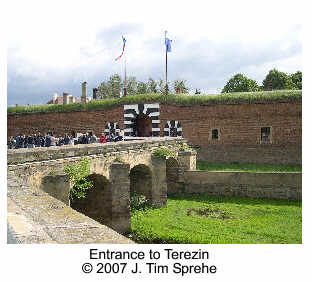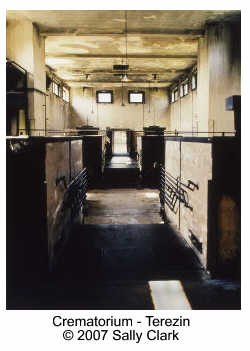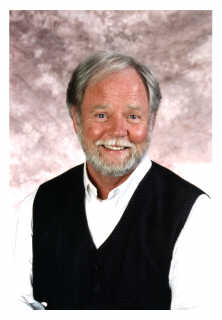|

Why Should We Remember?
The Terezin Ghetto
© 2007 Dennis Patrick Slattery, used by permission
[Images: "Entrance" and "Courtyard of Terezin" by Sprehe; "Terezin Children's Art" by Eisner; "Terezin Crematorium" by Sally Clarke]
 Prague, we were told for years by many who had visited, is an elegant, culturally rich city. So, on a recent trip to Italy for a conference, my wife and I stayed over and flew the short distance from Rome to Prague in what is now the Czech Republic. Since the city's mayor, during the Nazi era, unilaterally surrendered the city to the Third Reich in exchange for its not being bombed, it is intact and even more elegant than we had imagined. Prague, we were told for years by many who had visited, is an elegant, culturally rich city. So, on a recent trip to Italy for a conference, my wife and I stayed over and flew the short distance from Rome to Prague in what is now the Czech Republic. Since the city's mayor, during the Nazi era, unilaterally surrendered the city to the Third Reich in exchange for its not being bombed, it is intact and even more elegant than we had imagined.
While there, we signed up at our hotel for a tour of the Terezin Ghetto and concentration camp, which is about 25 miles north of Prague. A shuttle bus picked us up at the hotel, and we joined 15 others for a five-hour tour. The camp, created and directed initially by Reinhard Heydrich, Deputy Reich Protector, was a first step towards the liquidation of a people in what infamously came to be known as "the final solution of the Jewish question." Such an innocuous and ambiguous phrase — more of a slogan — camouflaged the horrific atrocity of eliminating an entire people from the earth.
According to a volume I bought at the bookstore in Terezin, the first transport arrived from Prague on Nov. 24, 1941, three years before I was born. On Feb. 16, 1942, a decree went out ordering all inhabitants of the town to pack their belongings and leave, virtually abolishing the town and hiding the atrocities that had begun within its walls. In that same year, mass transports of Jews from towns in Bohemia and Moravia began arriving. In all, about 190,000 Jews were deported to Terezin. Of that number, over 30,000 were cremated in ovens that still stand in a building outside the fort area. Many more died there, and the rest were shipped out to Auschwitz and other camps for extermination.
 Walking through the camp was chilling. It was impossible to comprehend cruelty inflicted on such a massive scale. Our group was subdued and reverent, speaking little. A fine museum there is filled with descriptions of the camp — empty suitcases, children's drawings, musical scores, journals, shaving utensils, clothing — all serving to pull the horrors of the project out of abstraction and into fleshy reality. All of it serves to trigger a single act for those who encounter it: the act of remembering. It was the act of remembering — and forgetting — that framed what happened next. Walking through the camp was chilling. It was impossible to comprehend cruelty inflicted on such a massive scale. Our group was subdued and reverent, speaking little. A fine museum there is filled with descriptions of the camp — empty suitcases, children's drawings, musical scores, journals, shaving utensils, clothing — all serving to pull the horrors of the project out of abstraction and into fleshy reality. All of it serves to trigger a single act for those who encounter it: the act of remembering. It was the act of remembering — and forgetting — that framed what happened next.
As we traveled in silence from the shower rooms to the laundry rooms, to the cramped quarters where wooden bunks still stand, to the isolation cells in a basement, my wife and I met a woman who first introduced herself as a Jew and then offered her name. She was there to remember her ancestors. At the same time, she told us, she was traveling with her 18-year-old daughter, who refused to join her on the trip to Terezin. The daughter insisted on staying at the hotel in Prague, telling her mother she "did not want to get depressed."
Rather than suffer the reality of the camp, she chose to deny it, her mother explained. She wished to deny the very existence of the place, the purpose of which was to ensure that the world not forget the lengths to which we human beings will go to inflict hatred and cruelty on our own kind.
Of course, the daughter is not alone. Remembering is becoming more and more a denied human action. But the action itself is more than that defined by the clinical term denial. It is the attempt to step out of history, to isolate oneself from a context and from understanding one's being as part of a larger legacy than one's plans for tomorrow. Worse, it is to deny suffering, being "uncomfortable," in order to keep intact the illusion that if one denies it, somehow suffering really does not exist.
In a provocative study, The Ethics of Memory, Avishai Margalit asks a simple but profound question: "Are there episodes that we ought to remember? Are there episodes that we ought to forget ...? The two questions thus amount to the question of the ethics of collective memory" (48). In other words, a moral and ethical obligation exists to remember certain events.
What criteria exist for an individual or a culture by which it determines what is to be forgotten and what preserved? One readily grasps the enormous social, political, and psychological implications that pivot on such choices.
 The young woman's mother had pain in her voice as she told us of her disappointment at her daughter's decision. Justly so; in her decision, from my perspective, are the outlines of a second holocaust — the holocaust of forgetting, of pretending that such suffering did not exist. Forgetting in this instance is yet another form of incinerating the past and exterminating the suffering of so many. The young woman's mother had pain in her voice as she told us of her disappointment at her daughter's decision. Justly so; in her decision, from my perspective, are the outlines of a second holocaust — the holocaust of forgetting, of pretending that such suffering did not exist. Forgetting in this instance is yet another form of incinerating the past and exterminating the suffering of so many.
Remembering and forgetting are moral actions, as powerful and life-sustaining or life-denying as any overt physical behavior. To deny the suffering of others blocks another level of remembrance, as we also witnessed during our journey to Terezin.
In the museum section of the ghetto were several rooms we were asked to visit. In one room was artwork by both children and adults, much of it magnificent. In another were musical scores. Our guide told us that music composed in Terezin is played today by orchestras worldwide. In another were toys and other carved objects made by those in the camp. They were signs of the human spirit that composed, created and made artistic works in such an austere place. The human spirit is just that resilient, not merely adapting to but actually creating out of such horrific conditions. The uncanny nobility of the human heart in the face of suffering must also be remembered.
Another of Margalit's insights is worth repeating here under a subheading entitled "Ethics and Caring," he develops the connection between memory and morality. "And caring, and especially the lack of caring, seems to belong quite naturally to morality. Indeed, some will hasten to add that caring should be regarded as the core attitude of morality" (32).
Caring is not synonymous with a sentimental feeling towards another or others. Caring is metaphysical in its depth and authenticity. If one stops caring for others, or even for one's self, one may lose the memory of that same self. The Terezin camp is there to be remembered or forgotten. To deny its presence and its history based on feelings of discomfort about how one might respond — that is immoral. It is a form of immorality, however, that is scarcely acknowledged today.
Its immorality lies in denying history and, especially, the myth that lives below the events of history. It is this myth that defines and drives the energy that initially fueled the original event. To attempt to live a mythless life is a futile effort to live outside of time and, perhaps, outside of space as well. It may, at the same time, sever us from humanity and from our own humane nature. Caring, by contrast, pulls us out of ourselves and into the reality of others; be they living now, 50 years ago, or millennia in the past.
We each have our own personal memory. But we also are obligated, I sense, to participate in a collective memory that lifts us out of our narcissistic tendencies and places us in a larger vessel of belonging. What an individual, a culture, a people, or even a species chooses to remember and forget, where it makes the cut between what will be allowed in and what will remain outside, defines that entity even more than one's fingerprints or biological heritage. Our identities are bound up with what we — as people and a culture — choose to forget as well as what we select to remember.
History lives if it is remembered. The remembrance of others nourishes history. History, in its ideal contours, is a witness to caring, not just for one's own ideas, people, person, or prejudices, but caring on an epic level of generosity. Terezin, Auschwitz, Birkenau, Dachau and all the others, should never be forgotten so that we do not lose the perspective on ourselves that they preserve. To forget allows their spirit to gather force and appear in the world again, looking brand new, like it never happened before.
To attempt to live outside of history creates a world of my own fabrication, a world that I may insist others adopt as their own. In such a utopia there exist only laws and behaviors that I deem appropriate to the exclusion of the tradition that rests behind all that we think and do.
 Just before we left, I picked up two stones in the courtyard where the new arrivals to the camp were herded as they disembarked from the boxcars. I carry one of the stones with me every day. Feeling it in my pocket helps me remember that I was there, that Terezin exists — for me, for all of us. The reality of that place, haunted by the tens of thousands of spirits that still dwell there — in the wood, in the ashes of the ovens, in the landscape they helped to sculpt — is as tangible as the stone I carry. Just before we left, I picked up two stones in the courtyard where the new arrivals to the camp were herded as they disembarked from the boxcars. I carry one of the stones with me every day. Feeling it in my pocket helps me remember that I was there, that Terezin exists — for me, for all of us. The reality of that place, haunted by the tens of thousands of spirits that still dwell there — in the wood, in the ashes of the ovens, in the landscape they helped to sculpt — is as tangible as the stone I carry.
In the conclusion of the book I purchased in Terezin, it laments that, after the 60 years since the end of World War II, "the facts about the suffering of the Jews and of their extermination during Nazi occupation, and in particular the story of the 'Ghetto' in Terezin were not exactly denied, but rather simply not told" (39). However, since 1989 when the Czech Republic threw off the cloak of Communism, the story is now being told with a vigor it previously had been denied.
A lesson: Let us not allow capitalism, often touted as the only mythos worth appropriating, to blindside us in the same way the mythos of Nazism blindsided those of another era. As our prevailing mythos, may it not obscure our memory of what the human spirit — in its sufferings and creations, in its glory and its horror — is capable of doing.
Notes:
-
Chladkova, Ludmila. The Terezin Ghetto. Pamatnik Terezin, 2005.
- Margalit, Avishai. The Ethics of Memory. Cambridge: Harvard UP, 2002.
 Dennis Patrick Slattery, Ph. D., is a member of the Core Faculty in Mythological Studies, Pacifica Graduate Institute. He is the author of 12 books, including 3 volumes of poetry, two with accompanying CDs. His poetry has appeared in many journals and magazines over the years. He has written more than 200 articles and reviews that focus on the confluence of culture, spirit, soul, myth and poetics. Dr. Slattery's work includes The Idiot: Dostoevsky's Fantastic Prince Dennis Patrick Slattery, Ph. D., is a member of the Core Faculty in Mythological Studies, Pacifica Graduate Institute. He is the author of 12 books, including 3 volumes of poetry, two with accompanying CDs. His poetry has appeared in many journals and magazines over the years. He has written more than 200 articles and reviews that focus on the confluence of culture, spirit, soul, myth and poetics. Dr. Slattery's work includes The Idiot: Dostoevsky's Fantastic Prince and The Wounded Body: Remembering the Markings of Flesh (Suny Series in Psychoanalysis and Culture) and The Wounded Body: Remembering the Markings of Flesh (Suny Series in Psychoanalysis and Culture) , and Station-To-Station: A Monastic Memoir. He is co-editor with Lionel Corbett of Depth Psychology: Meditations in the Field as well as Psychology at the Threshold, and a volume of poetry, Casting the Shadows: Selected Poems , and Station-To-Station: A Monastic Memoir. He is co-editor with Lionel Corbett of Depth Psychology: Meditations in the Field as well as Psychology at the Threshold, and a volume of poetry, Casting the Shadows: Selected Poems . His most recent work is a collection of poetry, A Limbo of Shards: Essays on Memory Myth and Metaphor . His most recent work is a collection of poetry, A Limbo of Shards: Essays on Memory Myth and Metaphor . He is a Fellow of The Dallas Institute of Humanities and Culture where he teaches the classics each summer to high school teachers in a Summer Institute for Teachers. He lectures and offers workshops to a variety of Jungian groups in the United States and Canada. . He is a Fellow of The Dallas Institute of Humanities and Culture where he teaches the classics each summer to high school teachers in a Summer Institute for Teachers. He lectures and offers workshops to a variety of Jungian groups in the United States and Canada.
Read more articles by Dennis Patrick Slattery in Mythic Passages
Return to Passages Menu
Subscribe to the Passages e-zine
|

